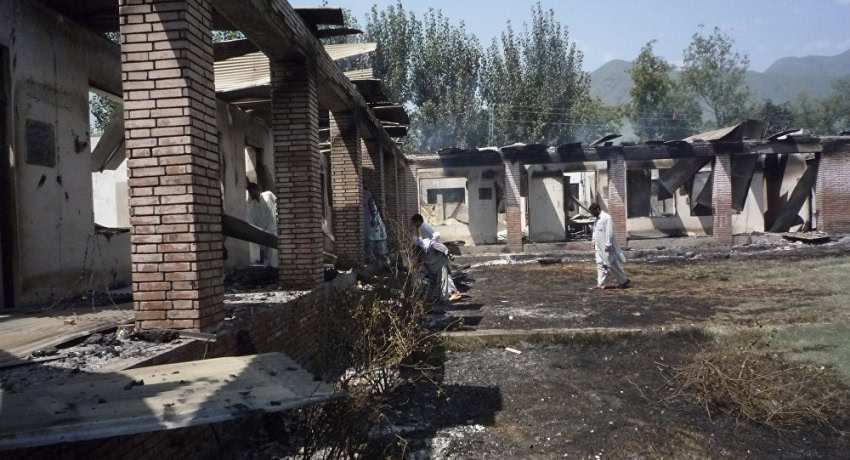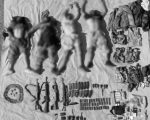While the sun of Naya Pakistan with an immensely high wave of change is about to rise in the mainland, girls’ education faces tremendous pressure in district Diamer of Gilgit Baltistan.
Unluckily, this time the aggressors don’t belong to any renowned militant group. Similarly, unlike the inhuman Taliban who, for instance, after taking control of scenic Swat valley, a tourist region, banned girls’ education by announcing, “From January 15, girls will not be allowed to attend school.”
This announcement was made at the dawn of January 2009 but the case is altogether different now as the latest attackers neither warned the people nor committed these heinous crimes in broad daylight.
Not one or two, but more than a dozen schools were set ablaze in a night while all the populace and administration including law enforcement agencies were deep asleep. Resultantly, neither was able to assertively nominate the culprits.
The intensity of hatred for girls’ schooling was evident in the act of burning the books outside the premises of some of the blown up institutions.
It was easy to understand when Taliban used to burn the educational institutions since they were savage and had firm belief that the girls’ education and women’s movement in society is un-Islamic, but these assailants are not TTP trained militants or ISIS according to the information minister of GB.
They have their own agenda which could only be speculated and assumptions are often easy to make in the land of pure. The most attractive and popular in likewise incidents is to blame the USA or neighboring countries. Simultaneously, it always results in an Army-led operation while the administration’s slumber continues. Schools get heavily guarded by security officers holding guns exposing kids to another trauma and fear.
Gilgit schools attacked
1. Primary School for Girls, Ronay, Chilas
2. Girls School Takya
3. Social Action Programme (SAP) Primary School, Hudur
4. Army Public School, Darel
5. Primary School in Tabor village, Darel
6. SAP Primary School, Tabor, Darel
7. APS in Tangir Valley
8. Primary School for Girls Sheegay Manikal, Darel
9. Primary School for Girls, Galee Bala, Tangir Valley
10. Primary School Galee Bala, Tangir
11. Primary School for Girls, Khanbary
12. Primary School for Girls, Gyal Village
Schools were set ablaze at once around 1 am while everyone was asleep except the perpetrators, according to the locals. One of the locals, Haider Khan a youth in his twenties, revealed that a small number of people amongst the dwellers of the mountains discourage the girls’ education but the majority of residents of Chilas believe that education is a fundamental right of every girl.
He added that the motive of burning the schools was to stop the government from building Diamer Basha dam while they targeted schools to exhibit and exert their dislike for girls’ education.
The children are always under immense pressure since their fear is doubled when they find themselves surrounded by guns. Already Pakistan has faced militancy but no significance to the factor of mental rehabilitation is given here.
Neither wiping out the militancy by killing them without a trial doesn’t guarantee the success nor exposing the youth to heavy weaponry and guns can provide an enabling environment ideal for quality learning.
Convincing parents to send their daughters to school was never an uphill task in Gilgit Baltistan largely but there is a stark difference between Chilas and the rest of the territory. In Diamer these attacks and threats have made parents think twice.
Which is amongst the ten lowest scoring districts in Pakistan where out of 16,800 enrolled students only 3,479 are girls, according to Alif Ailan. Schools are far and few in diamer, particularly for girls there are only 88 government schools. Unfortunately, Diamer, the whole district, doesn’t have any higher secondary schools, which adds to the miserable education conditions of the area.
On the other hand, it is indeed alarming that these narrow-minded people have gained so much power that they have successfully managed to attack education in a territory placed better than KP, Balochistan, Sindh and FATA (now a part of KP) in education, according to Alif Ailan.
Apart from other reasons, forcing the government and policymakers to neglect the Northern areas of Pakistan is its absence from National Assembly of Pakistan. If FATA even after being a tribal zone having their own system of administration had a stake in Federal Government then why can’t GB which is also having a unique culture distant from Azad Jammu and Kashmir? Similarly, if FATA is merged into KP than why can’t GB become a province?
Dynamics of politics depend on power than morality or legitimacy in Pakistan. For instance, every political party concentrates on Punjab since winning in the land of five rivers confirms government in the center. They know that the number of National Assembly constancies situated in Punjab exceed the number of seats required for a simple majority. This Punjab-centric politics and development have spread a sense of being neglected in the rest of the country.
Failure in implementing the law has created a vacuum which is filled by the powerful cults and criminals here. Even at the age of 71, Pakistan required Military courts to punish the terrorists while the traditional courts and prosecution system are neither capable nor intend to perform better.
The only consistency in punishment, notwithstanding the severity, can stop the crime and Imran Khan must work on this issue on priority basis.














